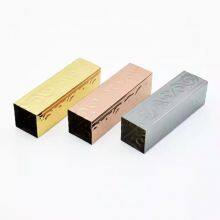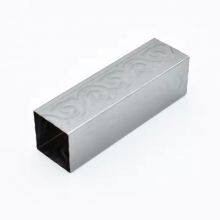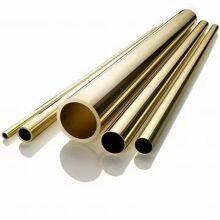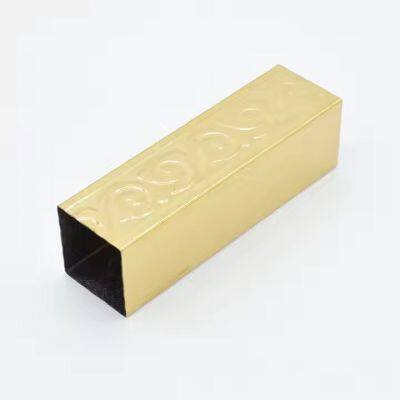Hot Selling 304 201 316 310s Material SS Color Stainless Steel Pipe Tube Gold Color Stainless Steel Rectangular Tube
Hot Selling 304 201 316 310s Material SS Color Stainless Steel Pipe Tube Gold Color Stainless Steel Rectangular tube
Application: Handrail, Handle, Display Shelf, Furniture Etc.
The application of coatings on materials is one of the most used strategies in the industry to improve their properties. By deposition of coatings, a wide range of characteristics of a material can be improved, from a tribological point of view to an aesthetic point of view.
In today’s blog, we present a technology that has great potential in the application of coatings. This technology is physical vapor phase deposition (PVD).
What is physical vapor deposition or PVD?
The origin of physical vapor deposition (PVD) arises from the combination of electricity, magnetism and the knowledge of chemistry in the gas state.
The concept of physical vapor deposition arose when coatings applied in a vacuum atmosphere were on the rise. In these years, different developments in technologies such as sputtering or plasma were carried out, where chemical reactions in the vapor state, thermal evaporations and the control of energy sources were involved.The PVD technique is a process in which a thin film deposition occurs on the surface of a material, growing atom by atom on the substrate. The physical deposition of vapor consists of a physical-thermal collision process that transforms the material to be deposited, called the target, into atomic particles, which are directed to the substrates in a gaseous plasma state through a vacuum atmosphere, generating a physical coating by condensation of projected atoms.
Coatings deposited by PVD tend to have thin thicknesses, which can range from atomic layers (less than 10 angstroms (Å) to 0.1 nanometers (nm)) to coatings of several microns (thickness of a hair fiber).
It is used in a wide variety of industries like optical applications ranging from eye glasses to self-cleaning tinted windows, photovoltaic applications for solar energy, device applications like computer chips, displays and communications as well as functional or decorative finishes, from durable hard protective films to brilliant gold, platinum or chrome plating.
The two most common Physical Vapor Deposition Coating processes are Sputtering and Thermal Evaporation. Sputtering involves the bombardment of the coating material known as the target with a high energy electrical charge causing it to “sputter” off atoms or molecules that are deposited on a substrate like a silicon wafer or solar panel. Thermal Evaporation involves elevating a coating material to the boiling point in a high vacuum environment causing a vapor stream to rise in the vacuum chamber and then condense on the substrate.
What Makes PVD Coatings Highly Durable, Corrosion and Scratch Resistant?
Being able to apply coatings at the atomic level using PVD allows control of structure, density and stoichiometry of the films. Using certain materials and processes, we can develop specifically desired attributes of the physical vapor deposited film like hardness, lubricity, adhesion and more.
These coatings can reduce friction and provide a barrier against damage. The applications for these coatings are ever expanding. Aerospace, automotive, defense, manufacturing and more where long lasting durability is crucial.
This type of physical vapor deposition coatings can also be highly resistant to tarnishing and corrosion, enabling them to be used for a wide range of decorative finishes with colors that do not fade. A PVD gold or platinum coating produces brilliant finishes that make watches highly resistant to scratches and scrapes that cause less resilient processes to wear off.
Titanium nitride and similar coatings offer beautiful finishes that are also very resistant to corrosion and wear. This makes them widely used on household items such as door handles, plumbing fixtures and marine fixtures as well as machining tools, knives, drill bits, etc. It produces coatings with superior hardness, durability and resistance to wear.
Are PVD Coatings Safe?
Physical Vapor Deposition processes are an environmentally friendly or “plating” technique that greatly reduces the amount of toxic substances that must be used, manage and disposed of as compared to other “wet” processes that involve fluid precursors and chemical reactions used to achieve the same result. Because it is capable of producing extremely pure, clean and durable coatings, Physical Vapor Deposition is the technology of choice for the surgical and medical implant industry.
Grade: 201 202 304 304L 316L 410 420 430 310S 321 904L 2205 2507
Steel Grade: 301L, S30815, 301, 304N, 310S, S32305, 410, 204C3, 316Ti, 316L, 441, 316, L4, 420J1, 321, 410S, 410L, 436L, 443, LH, L1, S32304, 314, 347, 430, 309S, 304, 439, 204C2, 425M, 409L, 420J2, 436, 445, 304L, 405, 370, S32101, 904L, 444, 301LN, 305, 429, 304J1, 317L,
Surface Finish BA/2B/NO.1/NO.4/8K/H
PVD applications
it is worth highlighting the precision and purity offered by physical vapor deposition to obtain coatings. The main PVD applications currently in use are as follows:
Metallic coatings to provide semiconductor properties to a substrate that initially are not.
Magnetic film coating.
Coatings for decorative purposes, widely used in the jewelry area.
Coatings for solar glasses or mirrors, which act as optical interference barriers or reflective barriers.
Conductive layers of palladium or carbon, for electron microscopy samples.
High hardness coatings of composite materials, resistant to wear and corrosion, widely used for the improvement of mechanical tools.
Development of golden colors using physical vapor deposition technology. In this project, the objective was to obtain different shades of golden color on metallic substrates. To carry it out, the optimization of the PVD process of different metallic targets and reactive gases was carried out. As can be seen in the photo, it was obtained from an intense gold to a lighter gold with pink tones.

Send Inquiry to This Supplier
You May Also Like
-
Stainless Steel316 High Pressure PT NPT Thread Double Ferrule Tube Connector 316L Stainless Steel Hydraulic FittingsUS$ 1 - 8MOQ: 1 Piece
-
Female Male Thread, BSPP/BSPT/ Metric/NPT SS304 SS316 FORGED Threaded Fitting Hex Nipple Hydraulic Fittings Hydraulic AdaptersNegotiableMOQ: 1 Piece
-
Flareless Bite Type AdapterTube x NPT Male Straight Adapter Female Male Thread, BSPP/BSPT/ Metric/NPT SS304 SS316 FORGED Fittings AdaptersNegotiableMOQ: 1 Piece
-
Flareless Bite Type Tube Union Flareless Bite Type Adapter Tube x NPT Male Straight Adapter Female Male Thread,NegotiableMOQ: 1 Piece
-
Flareless Bite Type Flareless Bite Type Tube Union Flareless Bite Type Adapter Tube x NPT Male Straight Adapter Female Male Thread,NegotiableMOQ: 1 Piece
-
Tube Fittings and Adapters Flareless Bite Type Flareless Bite Type Tube Union Flareless Bite Type Adapter Tube x NPT Male Straight Adapte ThreadNegotiableMOQ: 1 Piece
-
Top Sale Npt Bspp Bspt Stainless Steel Compression Fittings and Double Ferrule Tee Fittings 1/8in to 1in and 2mm to 25mm OEM&ODMUS$ 1 - 8MOQ: 1 Piece
-
Ferrule Fittings 304/316 Stainless Steel 10mm Double Ferrule Compression Tube Fittings With Different SizeNegotiableMOQ: 1 Piece
-
Ferrule Fittings 304/316 Stainless Steel Compression Tube Fittings Double Ferrule Tee Cross With Different SizeNegotiableMOQ: 1 Piece
-
Top Sale Npt Bspp Bspt Stainless Steel Compression Fittings and Double Ferrule Tee Fittings 1/8in to 1in and 2mm to 25mm OEM&ODMNegotiableMOQ: 1 Piece
































